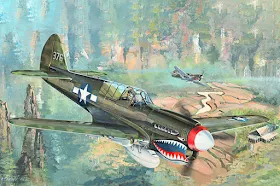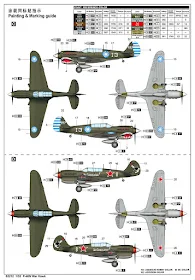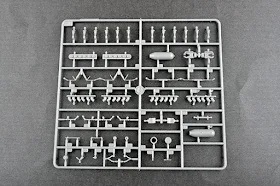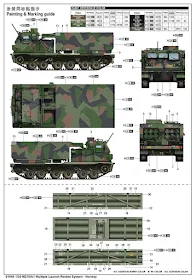Four new products should be hitting the shelves of your local hobby shop this month. Two with tracks, one with wings but three of them have a hull? See what we mean as we look at the boxart, decal and marking choices and sprue layout in our new item preview for August from Trumpeter.
Four new items with sprues, colours & boxart from Trumpeter in August
P-40N "Warhawk" fighter
Model Number: #02212
1:32nd scale
P-40N (manufactured 1943–44), was the final production model of the P-40. The P-40N featured a stretched rear fuselage to counter the torque of the more powerful, late-war Allison engine, and the rear deck of the cockpit behind the pilot was cut down at a moderate slant to improve rearward visibility. A great deal of work was also done to try and eliminate excess weight to improve the Warhawk's climb rate. Early N production blocks dropped a .50 in (12.7 mm) gun from each wing, bringing the total back to four; later production blocks reintroduced it after complaints from units in the field.
Supplied to Commonwealth air forces as the Kittyhawk Mk IV. A total of 553 P-40Ns were acquired by the Royal Australian Air Force, making it the variant most commonly used by the RAAF. Subvariants of the P-40N ranged widely in specialization from stripped down four-gun "hot rods" that could reach the highest top speeds of any production variant of the P-40 (up to 380 mph), to overweight types with all the extras intended for fighter-bombing or even training missions.
The 15,000th P-40 was an N model decorated with the markings of 28 nations that had employed any of Curtiss-Wright's various aircraft products, not just P-40s. "These spectacular markings gave rise to the erroneous belief that the P-40 series had been used by all 28 countries." Since the P-40N was by 1944 used mainly as a ground attack aircraft in Europe, it was nicknamed B-40 by pilots. Survivors redesignated as ZF-40N in June 1948.
Model size Length: 322.3mm Wingspan: 357.4mm
Total number of parts 140+
Etched parts 2 pcs
Total number of offsets 10 sprues and tires
- Detailed fuselage&wing w/accurate design
- A detailed cockpit, landing gear bays
- Rubber tires
M270/A1 multi-barrel rocket system - Norway 01084
Model number: #01084
Model ratio: 1:35th scale
The M270 MLRS (M270 Multi-Barrel Rocket Launch System, M270 MLRS for short) is a self-propelled rocket launcher weapon system with armour. Since 1983, the US military has used the M270 rocket launcher for the first time, NATO member states have begun to purchase some M270, and gradually become the standard weapon of NATO.
In the United States and European countries, a total of about 1,300 rockets, M270, were produced. In 2003, the M270 was officially discontinued after the final delivery of the Egyptian army M270.
Length: 200.5mm Width: 89.5mm
Total number of parts: 970+
Copper tube for tow cable included
25 sprues, lower hull, cab and tracks
Detailed multi-directional slide-moulded cab.
> multi-slide moulded lower hull
>184 individual tracks links
> Photo-etched parts included
Russian "Tashkent" destroyer 1940
Model number: #05356
Model ratio: 1:350th
Negotiations with Italian shipbuilders about the building of destroyer leader for the USSR have begun in 1935 and have come to the end with signing 9/9/1935 of a contract with OTO. The requirements provided considerable improvement of general performances in comparison with Leningrad: speed not less than 42.5kts, endurance not less of 5000(20)nm, armament consisted from 3 twin 130mm turret mounts, 6 45mm AA guns and 3 triple 533mm TTs. The armament should be fitted after the arrival of the ship to the USSR. 3/2/1936 Italian party presented the project which has received the index 20I. The decision on building of 3 ships in the USSR was simultaneously accepted, but because of differences in technologies, it was later refused. 18/4/1939 Tashkent was accepted by the crew and 6/5/1939 arrived in Odessa.
The ship had a hull with forecastle with appreciable deck sheer to stem and a cruiser-type stern. Prominent features of the leader were a completely covered bow streamlined superstructure smoothly transferring to the fore funnel, and covered storm corridor, allowing to be transferred on all ship length without an exit to an upper deck. Extremely powerful machinery placed en echelon. On trials, Tashkent reached 43.53kts at 3422t and 130000hp.
Under the project, the armament consisted of 3 twin 130mm/50 B-2LM turret mounts, but because of a protraction of availability of the latter, Tashkent at commission received temporary armament: 3 single 130mm/50 B-13 guns. Originally designed guns were installed in February 1941.
On the 27/6/1942 en route from Sevastopol to Novorossiysk Tashkent was hard damaged by German aircraft and 2/7/1942 sunk by German aircraft at Novorossiysk. By the summer of 1944, she was salvaged and broken up in 1946-1948.
Model Length: 399.1mm Beam: 39.1mm
Metal Anchor chain parts
6 sprues, hull and decks
- The kit contains over 210 parts
- the hull made from two-directional slide moulds
- Contains display stand
- photo-etched parts included
- PE parts included
Soviet JS-5 heavy tank 09566
Model number: 09566
1:35th scale
The 730 project was a heavy tank developed by the former Soviet Union during the Cold War and was intended to replace the KV and IS heavy tank series. In the development process, it was named IS-8.
Length: 278.7mm Width: 101.1mm
Total number of parts 530+
Copper cable for the tow cables included
23 sprues, lower hull and upper hull
The kit consists of over 530 parts
>Multi-slide moulded lower hull and upper hull
>180 individual tracks links
These new kits should be available from your LHS or Trumpeter's Distributors this month...













































